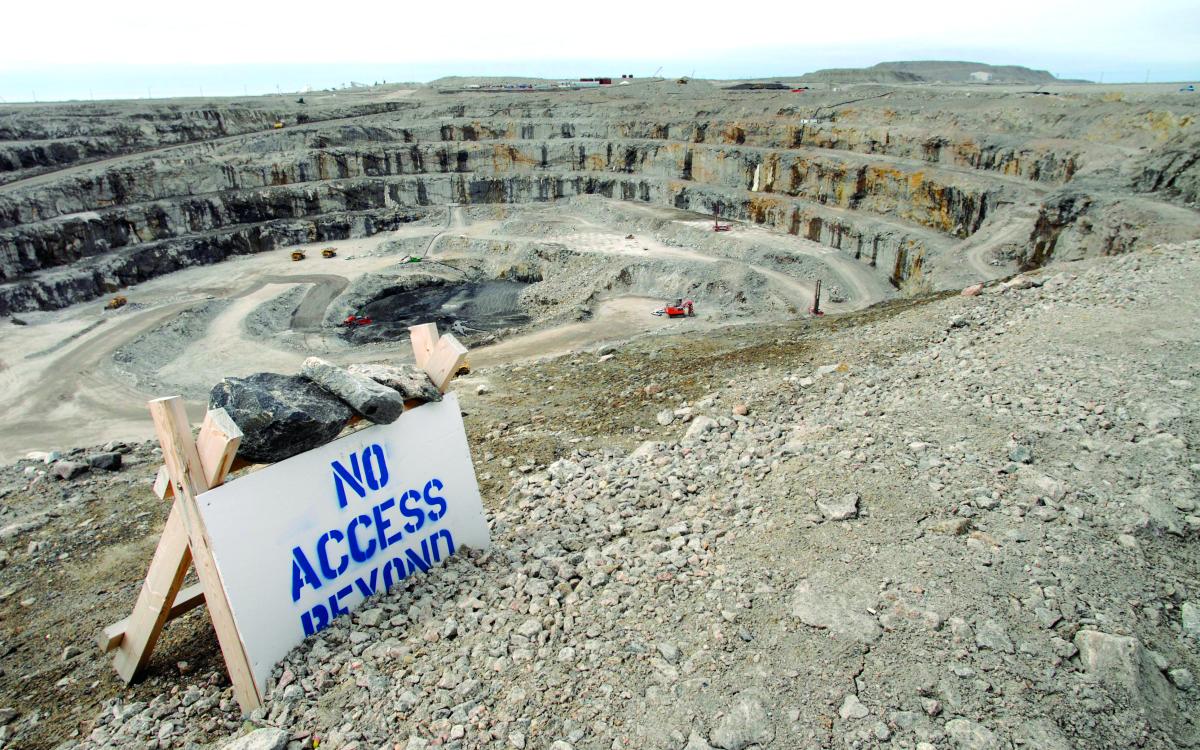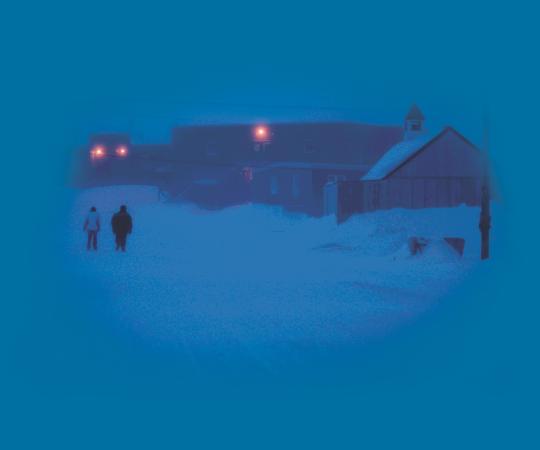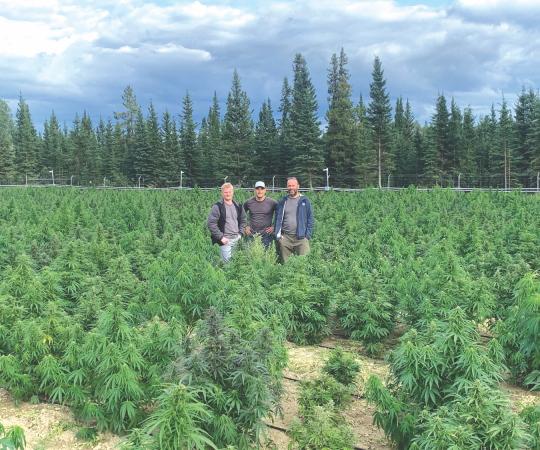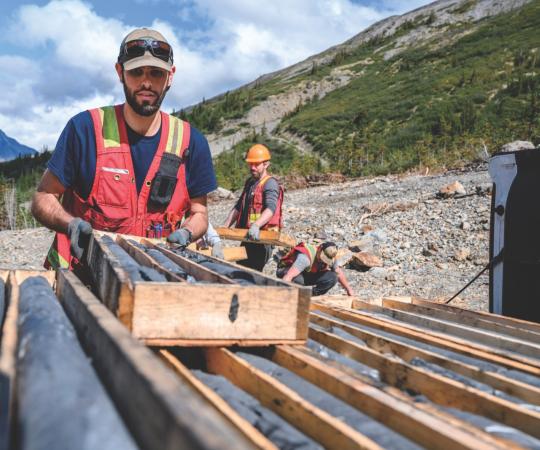TREVOR BOWER knows a countdown clock began ticking on his first day of work at the Diavik Diamond Mine more than 20 years ago. “From the day you start mining, you’re working yourself out of a job,” he says. “Eventually, you will mine the entire resource out, and the mine will have to close.” Diavik, 300 kilometres northeast of Yellowknife, is already living on borrowed time. When it opened in 2003, it was only ever expected to produce 100 million carats. By the time its owner, global mining group Rio Tinto, halts production in 2026, the company will have extracted more than 150 million carats of rough diamonds, making it the highest-producing diamond mine in Canada. Although Diavik’s remediation and closure work will last through to 2029 (and monitoring will continue for several years afterward), employment during those years will be a fraction of what it was during full operation. Many of the mine’s 1,300 employees, 437 of whom are northern residents, will need to find other jobs.
This is a cycle Northerners know well. In the years following the Great Diamond Rush of the 1990s, the NWT became home to a string of world-class mines. Overall, as of 2023, diamond mining represented 16 per cent of the territory’s Gross Domestic Product and 14 per cent of all jobs in the NWT. Besides Diavik, there’s Ekati, which began operating in 1998. In 2024, Ekati employed approximately 1,200 people, 28 per cent of whom were from the North. However, this summer, low diamond prices resulted in layoffs of hundreds of Ekati workers. The mine is now tentatively scheduled to continue operations until 2040.
Earlier this year, the Yellowknives Dene First Nation, the North Slave Métis Alliance, the Tlicho Investment Corporation and the Lutsel K’e Dene First Nation commissioned a report—Measuring the Effects of Diamond Mine Closures on Indigenous Communities in the Northwest Territories. It found that the price of diamonds has “significantly collapsed” in the last several years. The fear is that if market conditions continue their downward trend, mines will need to reduce workforces and/or shut down earlier than expected. Diavik is introducing a new phase to the familiar boom-and-bust rhythm of mining, though. The company developed an in-house program called MyPath that trains workers for life after this particular mine. Rio Tinto, which started offering the program in 2022, says it’s the first of its kind in North America.
By the end of 2024, more than 770 workers had participated in MyPath, which lets employees choose one of five areas: retraining for another career; help with starting a business; assistance in transitioning to retirement; moving to another company owned by Rio Tinto; or training for a similar role at another company. Training can include anything from getting help with writing resumés and preparing for interviews to, in one case, becoming a certified firefighter.
For Kelly Clarke, MyPath provided resources to help bolster her family’s business, North of 60 Aurora Adventures. Clarke has run the company with her husband, Larry, and their three children, since 2019. Clarke, the payroll manager at Diavik, says she plans to focus on Aurora full time once her role at the mine ends. Through MyPath, she was able to work with a web designer to improve the business’s marketing and website, which is now a slick, minimally designed page, with easy-to-book calendars and photo galleries of excited sled dogs and northern lights. “We’ve known for years that closure is imminent,” she says. Diavik’s transparency as it’s moved toward that date has been important for workers like Clarke, who need to keep working even when the work is gone.
DIAMOND MINING contributed $2.1 billion in production labour to the NWT economy in 2023; however, some of the mines responsible for this revenue will cease production within the next five years. In 2015, De Beers Snap Lake Mine closed. De Beers’ Gahcho Kue Mine is scheduled for closure in 2030.The Ekati Mine was also slated for closure by 2030, but the company announced this year that it could remain open until 2040.
Bower, who started at Diavik as a contractor operating a drill, has progressed to heavy mobile equipment advisor. Now, he’s in charge of maintenance planning for all surface heavy mobile equipment and light mobile. On the side, he’s started his own contracting business, but he says he hasn’t decided exactly what he’ll focus on. Over the years, he’s purchased pieces of equipment that he may rent out to folks for do-it-yourself landscape projects. It’s one of the avenues he’s exploring as a backup when Diavik cools down.
“One thing Rio Tinto has been really good at is keeping us well informed about everything moving forward,” he says. “I know people that have taken courses and completely changed the trajectory of their careers.” If you want to pursue re-education as an electrician, for example, Diavik will pay for it through MyPath.
But will the new jobs that come out of this re-training pay the same wages? That’s one of the big questions for Paul Gruner, chief executive officer of the Tlicho Investment Corporation.
IN 2023, diamond mines were responsible for 353 direct and indirect jobs for residents in Yellowknife (74 per cent), South Slave communities (15 per cent) and Tlicho communities (six per cent). The wages and salaries earned by these employees totalled $39.6 million in 2023. According to the Measuring the Effects report, “The lost business will be devastating for the Indigenous Development Corporations. Contracts with the diamond mines represent 54 per cent of their total gross output.”
To Gruner, losing some of the “bigger player” mines is a larger problem than just lost work opportunities (although that will be an issue). Professionals in the mining industry often earn six-figure salaries. Replacing their jobs doesn’t just mean creating employment; it means creating employment with the same earning power. Transitioning from mining to an industry like tourism may mean someone still has a job, but the income potential may not be comparable. “Let’s be honest here,” Gruner says. “None of that is going to come close to paying you $100,000 plus a year.”
That’s especially significant for Indigenous mine workers. On average, they earn $93,000 per year. Comparatively, Statistics Canada reports that the average income for Indigenous Canadians is roughly $54,450, although location and other factors can impact these numbers. If Tlicho workers can’t find comparable wages at home, there’s a possibility that they may have to leave the territory to do so.
The solution is simultaneously simple and complex—bring more resource extraction to the territory, says Gruner. For the past 30 years, the NWT has been collaborating with prominent industry leaders, including Diavik and De Beers. Gruner says capitalizing on the success of these relationships will be vital moving forward. “We need to take our learnings and build on those with future mining companies interested in developing in the NWT and the North,” he says.
Without significant investment from the federal government though, it can be challenging to attract industry to the North. “It’s not that we’re competing with the rest of Canada; we’re competing with the world,” Gruner says. “These are international mining companies and they’re going to go where they like.”
It doesn’t help that market conditions—supply chain issues, tariffs, the popularity and affordability of lab-grown diamonds, the spending habits of millennial and Gen Z buyers—have pushed diamond prices down to their lowest this century. That’s part of what’s shortening expected timelines for mines like Ekati and Gahcho Kue. Gruner thinks federal investment in infrastructure is essential to attracting companies and making the NWT a viable option. In the meantime, working toward development with long-lasting economic impacts is fundamental to the territory’s future. That means things such as all-season road access and reducing the financial challenges that could deter future mining projects, including the high cost of producing power—the NWT (and Nunavut) have the highest electricity costs in Canada.
It also means building businesses, creating training and development opportunities and stimulating entrepreneurial opportunities. “We can buy ourselves time, but we cannot afford to waste the next eight to 10 years. It’s super critical,” Gruner says. “We have to be building the long-term strategy for what is the next generation of economic opportunities in the territory, in the North.”
PRESTON DOOLITTLE feels like Diavik is supporting him in doing exactly that. Doolittle, a citizen of the Délı̨nę First Nation, began his career at the mine in 2016, working as an underground helper and lube technician in the mine’s mobile maintenance shop, where all of Diavik’s underground equipment is repaired and maintained. When he heard about the mine closure, he signed up for the MyPath program. In 2025, Doolittle was certified as a Red Seal heavy equipment technician. Diavik paid for Doolittle’s commercial driver’s licence training (Class 1) and then offered him the opportunity to apprentice as a heavy-duty technician. In the NWT, a heavy-duty equipment mechanic earns an average $98,000 per year. Contractors and heavy mechanic supervisors earn even more, at about $111,000 per year.
When Doolittle’s work at Diavik ends with the closure in 2028 or 2029, he plans to find employment that makes use of his skills and training as a heavy-duty technician (which, beyond mining, can include construction and transportation) or possibly start a business as an independent contractor. He, like Bower, has always known that one day their work at the mine would end. But Bower thinks Diavik is a great example of how a company can work to make that ending less painful. “I’ve raised two kids through working here,” Bower says. “It’s given me a great life.”










